Product Page SEO: 14 Best Practices to Drive High-Intent Traffic to Your Products

Social media, marketplaces, and comparison sites are great tools to drive traffic to your website. But none of them beat search engines.
Almost half of shoppers begin their product search on a search engine like Google or Bing.
Ecommerce search engine optimization (SEO) is the marketing practice that’ll help you appear in the search results of potential customers actively looking for the products you sell through a search engine.
By optimizing your product pages, you’ll capture bottom-of-the-funnel customers that are ready to purchase a new product. Chances are, these searchers are receptive to trying new brands—otherwise, they’d purchase through a direct marketing channel.
This guide shares the importance of SEO alongside 14 product page optimization techniques that will drive high-intent traffic toward your products.
#cta-visual-pb#<cta-title>Optimize every page for SEO in a flash<cta-title>Try Shogun for free and start building product pages that are optimized for SEO and customer experience. Start building for free
What is product page SEO?
Product page SEO is the process of optimizing an ecommerce product page. The goal is to make the page appear in search results when a target customer searches for related terms.
Common product page SEO tactics include:
- Optimizing images
- Using keywords
- Writing a click-worthy meta title and description
- Improving the user experience
- Formatting product page content in a way search engines can understand
Why is it so important to optimize product pages for SEO?
Google is the largest search engine in the world. Its platform processes over 8.5 billion search queries each day, with almost half of customers using it to discover new products.
Ecommerce sites that appear in these search results reach people when they’re in the mood to shop.
Let’s put that into practice and say you’re a consumer looking to buy a new skincare product. You do a Google search for the term “vitamin cleanser for dry skin”.
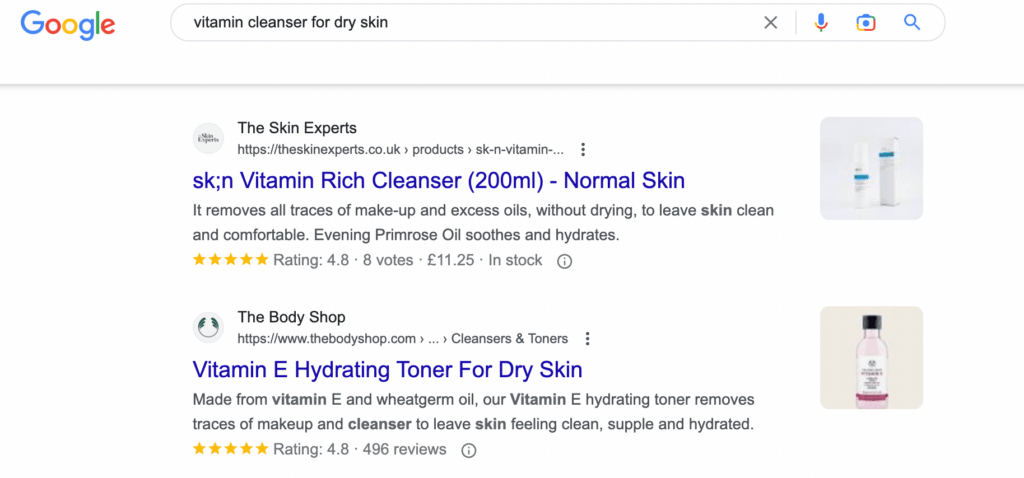
Thanks to Google’s rich results feature (more on this later), you can compare up to 10 product listings directly from the search engine results page (SERP).
Product Schema shows each item’s price, star rating, and availability—all before you commit to one.
Potential customers are likely already doing this mini-comparison for your inventory. If you don’t appear on page one, competitors are likely stealing customers that’d love your products.
But Google isn’t the only search engine you can appear in when product pages are optimized.
The platform has a plethora of other mini search engines that can drive traffic to your ecommerce store, including:
- Google Images – a feature used by one billion people each day
- Google Shopping campaigns – a free tool offered by Google that allows product listings to appear in the Shopping section of search results (plus the ability to run paid product ads)
#cta-visual-pb-ee#<cta-title>Improve conversions and average order value<cta-title>Learn how to optimize landing pages from the Shopify brands who’ve perfected them.Download the ebook
14 Ecommerce product page SEO best practices
- Do keyword research
- Target keywords in the title tag
- Write a click-worthy meta description
- Optimize product photography
- Write targeted product descriptions
- Use heading tags
- Add user-generated content
- Add product Schema for structured data
- Keep product URLs clean
- Build internal links
- Improve page load speed
- Optimize the breadcrumb navigation
- Make product pages mobile friendly
- Build backlinks to product pages
1. Do keyword research
The first step in any ecommerce SEO checklist is to understand which terms your target audience is searching for to a specific product like yours.
The goal is to appear in the search results for those keywords, which is possible by including these terms naturally throughout your product page content.
Start your keyword strategy and discover these terms through:
- Keyword research tools. Ahrefs, Keywords Everywhere, and Semrush show important keyword data for each search term, including the amount of people who search for it per month (search volume) and how difficult it’d be to rank for it. They also show related terms around a primary phrase for further digging.
- Competitive analysis. Do a Google search for what you’d assume would be the most obvious keyword for each product. Analyze the product pages already ranking for that term. What secondary phrases do they use to describe a product?
- Asking existing customers. Reach out to the people who’ve already purchased your product and ask how they discovered it. What terms did they search before finding it? If they were to buy it again, which phrases would they Google?
Bear in mind that not all keywords are good keywords—especially for product pages.
The desired outcome of a product page is a sale. Exclude terms with other search intents—like “how to” phrases that indicate a searcher is looking for information (so, better for a blog post).
Shortlist terms with transactional search intent. The people searching for them are ready to buy.
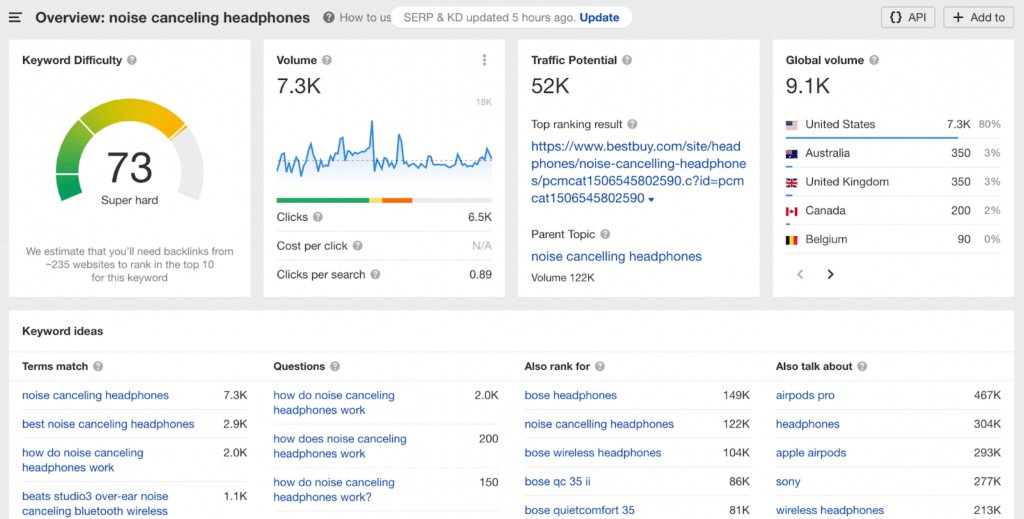
2. Target keywords in the title tag
A title tag is the page’s main title.
Search engines use it to understand the context of a product page, and therefore, where it should rank. This large, purple-colored text is also an opportunity for you to capture a searcher’s attention.
Best practices for optimizing a product page’s title tag include:
- Frontloading the main keyword. Include the page’s main keyword at the start of your title tag, followed by its official product name.
- Using a divider (|). Make your title tag more digestible by breaking up each section, such as the keyword and product title, with a divider.
- Including your brand name. If your company has an established brand with strong recognition, use this to your advantage in the SERPs. Add your brand name at the end of the title tag to convince repeat shoppers to return.
Yellow Leaf Hammocks is one DTC brand using this strategy to optimize its product pages.
The listing for its rope hammock, for example, is frontloaded with the main keyword a customer would search to find it: “Natural cotton rope hammock”.

Pro tip: Capture searchers looking to buy with a mini call to action at the start of your title tag, such as “Buy”, “Shop”, or “Browse”—i.e. “Shop natural cotton rope hammock”.
3. Write a click-worthy meta description
A meta description is the gray text that appears beneath your product page’s title tag.
While meta descriptions themselves aren’t a known ranking factor, they do influence organic click-through rate (CTR)—the percentage of people who see your result in the SERP and click through.
The number of people who see your result and click through influences rankings.
You’ve got up to 155 characters to play with here, so experiment with different formats and see which approach has the highest click-through rate.
That might mean:
- Detailing the product benefits
- Sharing your unique selling point (USP)
- Including keywords to connect with people searching the same term
Need inspiration? Look at the meta description on Everyday Humans’ sunscreen serum.
It pulls on a pain point its target audience usually has: finding a single product that combines skincare and suncare. There’s a short list of benefits from using the product to sweeten the deal.

The most important quality is that your meta description accurately describes the product page a person is about to click on.
If the meta description is misleading, searchers might click your result but head back to the SERP, contributing to a high bounce rate.
4. Optimize product photography
The product photos on your ecommerce store are arguably one of the most important elements of selling online.
Not only do three-quarters of customers rely on product photography when buying online, but when images are well-optimized, they can help product pages rank higher in search results.
Create high-quality images or videos that show shoppers the complete view of the items they’re thinking about buying. It can play a role in preventing people from exiting your website and worsening user engagement metrics that Google takes into account.
(There’s also the added bonus of reducing returns; 22% of online-bought items are later returned because the product looked different in the flesh.)
“One of the disadvantages of online purchasing is that you cannot touch or physically examine the product you are considering. This void can be filled by high-quality images and videos that provide end users with the confidence they need to make purchases.”
— Matthew Appleton, ecommerce manager at Appleton Sweets
Evelyn & Bobbie, a DTC brand that uses Shogun Page Builder, shows several angles of its wireless bra. Online shoppers also see a 360-view video to fully understand the product before purchasing.
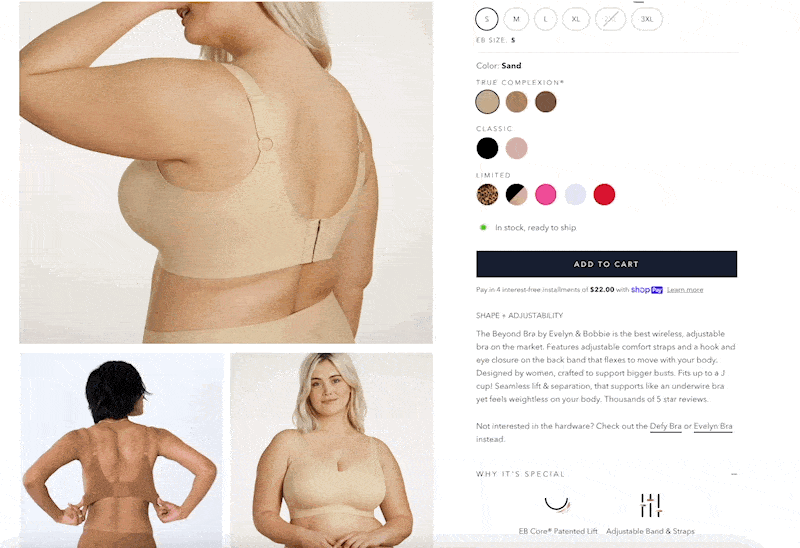
As we already know, optimizing user experience is only one part of the puzzle.
Search engines can’t understand image content. They look for context around an image to determine what the page is talking about and where the photo should rank in image-based results.
Optimize product images for SEO by:
- Writing descriptive alt text. This HTML code allows people using a screen reader to understand product images. They also help Google understand the context of an image. Write descriptive alt text that includes your target keyword and succinctly describes what the image is showing.
- Including keywords in the file name. Before uploading photos to your ecommerce site, name them with a descriptive title using hyphens to separate each word. A file named “nike-dunk-sneakers” is more understandable to search engines than “IMG-93803.jpg”.
- Compressing images. Page speed is important for SEO (more on this later). Plus, not many shoppers will hang around until a page loads. Compress and resize images to make product pages load faster.
5. Write targeted product descriptions
Product descriptions give important details about any given product. They’re not just important for user experience, though—search engines use them to understand the context of a page.
Create unique content for each product page you’re optimizing to avoid duplicate content.
When two pages have exactly the same content, search engines can’t differentiate between the two and will rank both URLs lower.
When writing yours, treat each product description as a way to target the transactional keywords you identified in the first section of this guide. Sprinkle these long-tail keywords throughout the product description and prove to Google that your product is the best option for a searcher.
The Ridge is a superb example of how to optimize product descriptions for SEO.
It targets secondary keywords a person might search when looking for its wallets, such as “RFID-blocking wallet” and “RFID-enabled cards”.
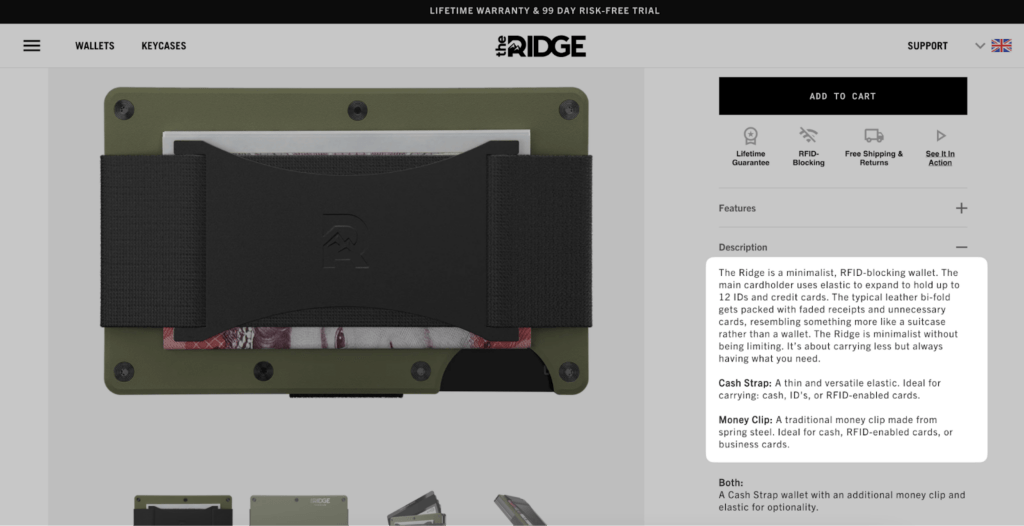
It’s easy to go overboard when optimizing product descriptions.
Find a balance between including the page’s main keywords, while also ensuring that the content is readable and makes sense to site visitors.
#cta-visual-pb#<cta-title>Become a product description pro<cta-title>Discover the tips and techniques top DTC brands use to optimize their product descriptions. Download the ebook
6. Use heading tags
Heading tags give search engines a quick summary of your product page.
At a glance, these mini subheadings can support Google in contextualizing your content—helping it decide which keywords to rank for.
Best practice is to include the page’s target keyword in your heading tags and keep each one short and sweet.
“Ensure that your product titles include trending keywords and that they speak to your target audience. Additionally, make sure they are not too long. This will allow your product pages to rank higher in Google searches.”
— Marilyn Zubak, director of acquisition and partnerships at Snif
Hierarchy is important, too.
You should only use one Heading 1 (H1) tag for your page’s main title. Heading 2 (H2s) sit beneath this and act as main subheadings, with Heading 3 (H3) below those for extra detail relevant to the H2 above.
Here’s an example of what the heading hierarchy looks like on Let’s Disco’s product page for its face cleaner stick:
- H1: Face Cleanser Stick | Cleanse & Rejuvenate Oily, Acne-Prone Skin
- H2: Charcoal Face Cleanser Stick
- H3: Pairs Great With
- H3: Hydrates Skin
- H3: Accelerates Skin Turnover
- H3: Removes Impurities
- H3: Disco vs Other Brands
- H2: Charcoal Face Cleanser Stick
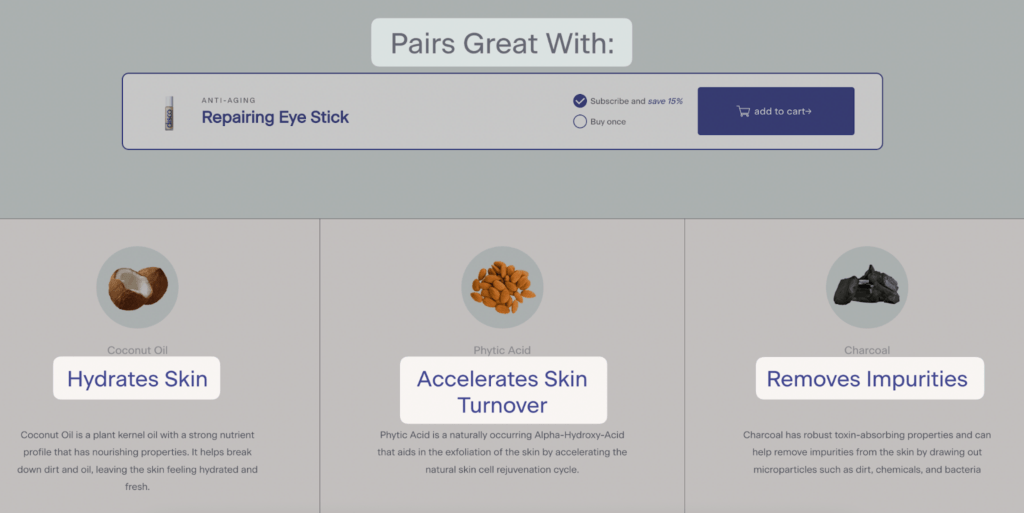
The added advantage of heading tags for product page SEO is that it makes content easier for readers to digest.
Walls of text are overwhelming, and if people can’t find the information they’re looking for, there’s a high chance they’ll exit your ecommerce site and head back to the SERP.
This increases dwell time—the amount of time organic searchers spend on your website before heading back to the SERP.
It indicates to Google that your product page didn’t solve their problem and needed to find another online store that did, which affects rankings.
7. Add user-generated content
The longer you can keep a person on your website, the better.
It indicates to Google that people are finding your product page content useful.
Influence people to increase the time they spend engaging with your website with user-generated content (UGC). The vast majority of customers trust UGC more than branded content.
And, when implemented on your ecommerce store, it has the potential to generate sales.
Experiment with UGC on your product pages to improve user experience, and therefore, rankings. That includes:
- Reviews or testimonials
- Instagram Reels or TikTok videos
- Social media shares
- Endorsements from experts or influencers
- Features in a recognizable publication
Mattress brand Leesa, for example, already had 350,000+ people visiting its website to search for a new mattress each month. The hard part was convincing them to stick around.
Leesa chose Shogun to move towards greater operational efficiency and craft elevated product pages that were more “sticky”. This included a social proof bar—a carousel of endorsements from well-known publications like Wirecutter and Apartment Therapy.
The Leesa team said, “The social proof bar was created just once by our development team and reused over and over again on all the other product pages. Reusing custom elements empowered our marketing team to create beautiful content without involving the development team.”

Since switching to Shogun Page Builder, Leesa has seen a 30% increase in conversion rate and a 20% increase in average order value.
Its development team has saved approximately $250,000 per year in development costs alone, making the team 90% more efficient.
#cta-visual-pb#<cta-title>Design your best store<cta-title>Try Shogun for free and start building product pages that are optimized for SEO and customer experience. Start building for free
8. Add product Schema for structured data
Schema markup is a type of code that formats data in a way Google can understand. It uses this data to display product-related information in the SERP (also known as “rich results”).
With product-related Schema, shoppers can see the following data directly within the SERP:
- Price
- Reviews
- Star rating
- Availability
- Shipping information
DTC brand (and Shogun customer) Nuun uses Schema on the product page for its sports hydration drink.
Potential customers can see its 4.8-star rating and 1,900+ customer reviews directly from the SERP, giving Nuun a competitive advantage and enticing shoppers to click through.

Schema can have a steep learning curve since it requires technical know-how. However, there are several apps designed to automatically create rich snippets from your product pages, including:
- Shopify: Schema Plus for SEO, Webrex, and Plug In SEO
- BigCommerce: SEO Rich Snippets, SEOKart, and Product Review Container
You can also create Schema using this Schema Markup Generator.
It’ll produce JSON-LD code you can add to your Shopify or BigCommerce product pages’ HTML code, which you can validate with Google’s Rich Results Test.
Just bear in mind that any changes to your website’s theme code can throw the entire thing off.
Consider getting support from professional ecommerce website developers and backing up your theme before making any changes.

9. Keep product URLs clean
A product page URL is the link that takes searchers directly to that page.
They’re not just important for user experience; clean product URLs are taken into consideration when Google determines where a product page should rank.
Best practices for product page URLs include:
- Including the target keyword. Asystem, for example, uses /pre-workout for its pre-workout formula.
- Use hyphens for spaces. Avoid merging words all in one or underscores to separate words. For example, Tipsy Elves uses the self-explanatory URL /womens-pink-easter-bunny-easter-jumpsuit.
- Keep it short. Backlinko found pages with a short URL outrank lengthier ones. Stick to a maximum of 66 characters—the average URL length for a page on the first page of Google.
Rumor is that URL structure doesn’t directly impact search rankings.
However, people are much more likely to interpret a URL that doesn’t hit this criteria as spammy—especially since Google shows the topline URL structure in its search engine results.
It’s why Google’s guidelines recommend merchants use “URLs with words that are relevant to your site’s content and structure are friendlier for visitors navigating your site.”

10. Build internal links
Internal links connect two unique pages on your website and help search engines navigate your website.
Product pages with many internal links indicate to crawlers that the page is of high value—and therefore, should be ranked highly in search results.
“A well-optimized site architecture and internal linking structure can help distribute link equity throughout your site, which can boost the authority and ranking of individual product pages.”
— Jason Berkowitz, CEO of BreakTheWeb
Build internal links between product pages and other pages on your online store. That could be:
- A related products section that connects one product to another
- Links from blog posts to relevant products
- Links from category pages to individual products
Jeff Neal, owner of Critter Depot, used this product SEO strategy to build internal links to product pages. He says: “Our primary SEO we did to boost our product pages was to create blog articles that complimented the insects we sell.”
“When we started, our content focused on the health benefits of crickets. This was decent content for our product pages. But it attracted people who already knew they wanted crickets as feeders for the reptiles. We then made a pivot with our content strategy, and started writing care guides for popular reptiles like bearded dragons and leopard geckos.”

Jeff says this blog content attracted a new demographic of people who didn’t know they could buy crickets online: “When they discovered our content, they then discovered they could buy from our store, which led to a very low 36% bounce rate, and a whopping 10% ecommerce conversion rate.”
Pro tip: Optimize the anchor text—the clickable text over a link—to describe the page you’re linking to. If you’re building internal links to the product page for your heatless curlers, for example, use the anchor text “heatless curlers” or “heatless hair styler”.
11. Improve page load time
Did you know that almost 70% of consumers think page speed impacts their likelihood of purchasing from an online retailer?
Slow page load times impact user experience, which has a domino effect on organic rankings. It’s why platforms like Google have been actively rewarding websites that load fast—a search engine ranking factor that originated back in 2010.
As Jay Ives, founder and CEO of Jives Media, explains, “No one wants to wait for a slow-loading page, and if they don’t find what they’re looking for quickly, they’ll likely go elsewhere.
“This can have a negative impact on the visibility of product pages in search engine results.”
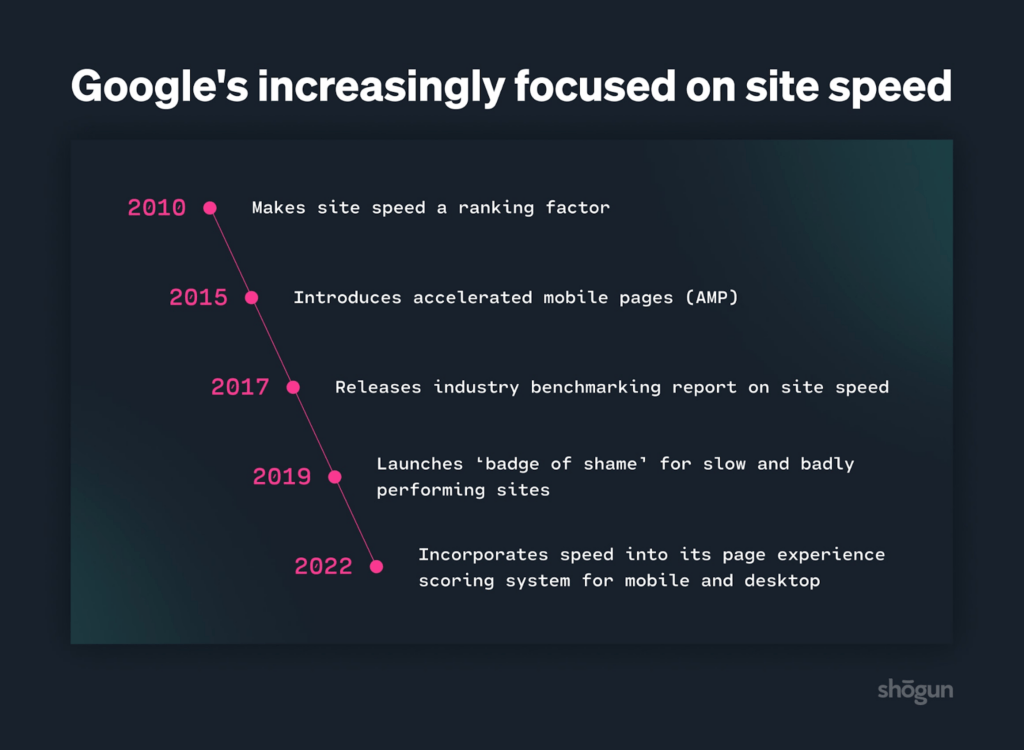
Measure your current page load speed on both mobile and desktop using Google PageSpeed Insights.
Aim for sub-second page load speeds. It’s at this point website visitors tend to drop off and search for a competitor website that loads almost instantly.
Falling behind? The tool will show areas of improvement specifically for your online store. Whether it’s minifying code or compressing images, when it comes to page speed for SEO, every little bit helps.
“At Inyouths, we have seen a dramatic increase in rankings for product pages after optimizing them for site speed and making our website mobile-friendly. We have also seen increased customer engagement and satisfaction as our website has become easier to navigate.”
— James Smith, co-founder of Inyouths
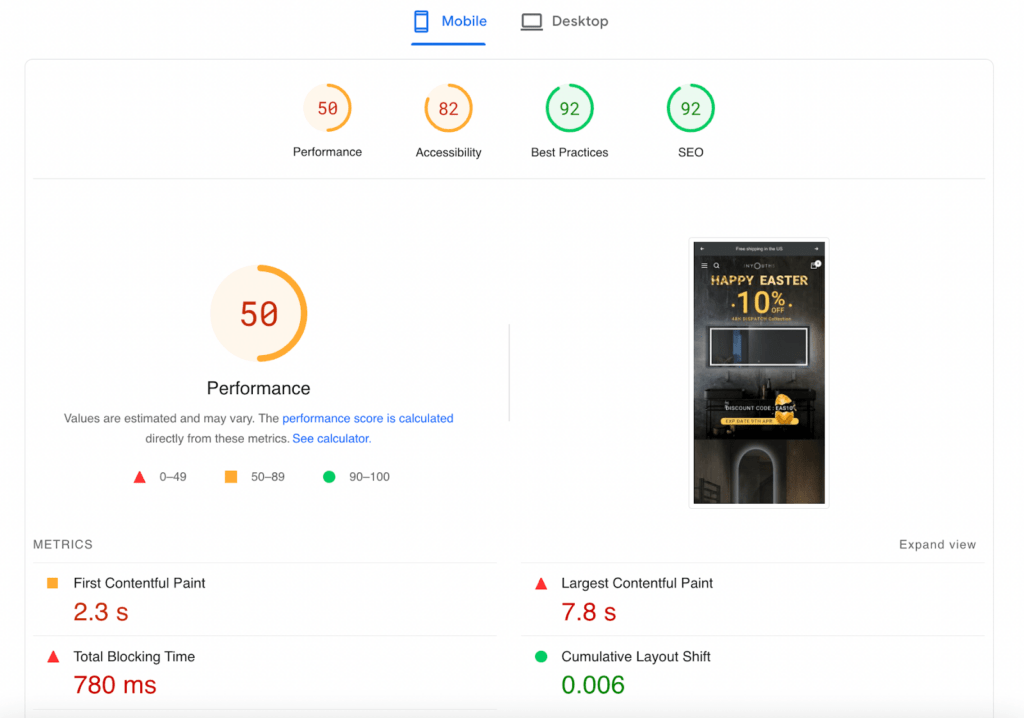
12. Optimize your breadcrumb navigation
Navigation features help online shoppers find their way around your website.
This includes the breadcrumb—a small navigation bar that shows the natural path from the homepage to the product page.
Breadcrumb navigation is a user experience tool particularly useful if you’re driving organic traffic directly towards a product page.
If someone lands on the product page for your men’s electric toothbrush, for example, they can see the subcategory it falls into (i.e., men’s toiletries). They click the link in the breadcrumb to shop related products.
This product page from YETI shows how someone would discover its tote bag—from the main “Shop” homepage to its tote bag category page.
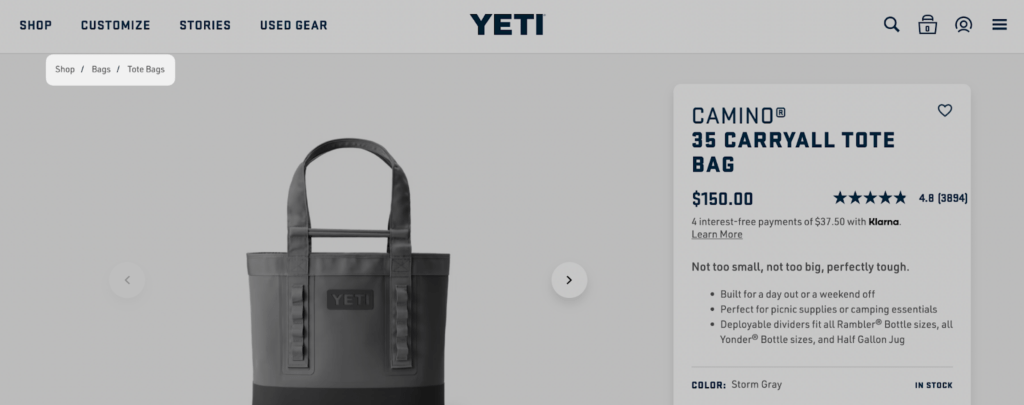
Search engines also use breadcrumb navigations to display extra context in the search results.
When potential customers see Yeti’s product page in their search results, they can quickly scan its breadcrumb navigation.
This extra context can prove to shoppers that the result fits their context (i.e., a tote bag available to buy).

13. Make product pages mobile-friendly
It’s no secret that we’re living in a mobile-obsessed world.
This is reflected in search and shopping behavior. Studies have shown that 63% of Google searches happen through a mobile device, and by 2025, we’ll collectively spend $710 billion on mobile shopping.
This move to mobile is encouraging search engines to prioritize mobile-friendly websites.
As Jay Ives of Jives Media says:
“A mobile-friendly design makes it easier for searchers to find your product pages when searching on a mobile device, since it ensures that the page is optimized for the smaller screen size and touch interface.
“This eliminates the frustration of having to zoom in or scroll around to find the information they’re looking for,” Jay says. “It also makes it much more likely that a searcher will stay on the page and complete their purchase.”
Tosi is a superb example of how you can make product pages mobile-friendly. This product listing for its almond snacks, for example:
- Offers adjustable text sizes
- Uses big finger-friendly call-to-action buttons
- Highlights product photography in a carousel layout (a feature familiar to mobile users thanks to platforms like Instagram)
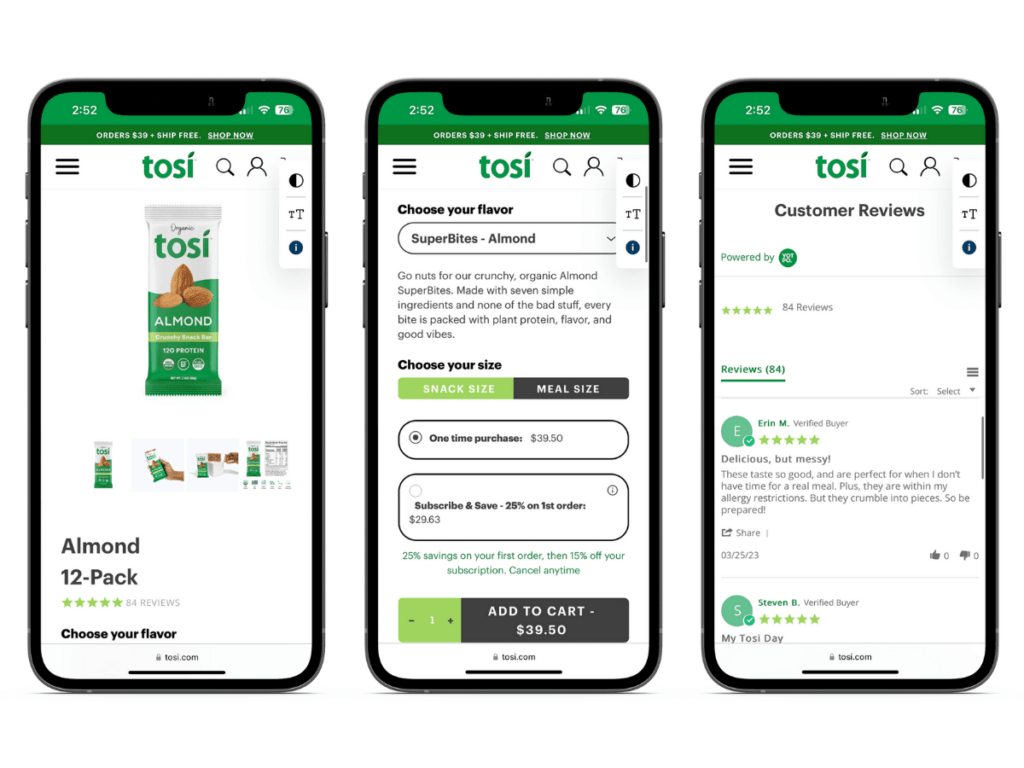
#cta-paragraph-pb#Use Shogun Page Builder to quickly build and customize product pages from Shopify and BigCommerce that are optimized for search and mobile shopping.
14. Build backlinks to product pages
You can have the best-optimized product page on the internet.
But if you don’t have any external seal of approval that your page content is unique and valuable, it’ll be much harder to make the page appear in the SERP for your target audience.
Link building is an off-page SEO strategy that gets other websites to virtually “vouch” for your online store.
But instead of driving these links toward your homepage or blog content, build backlinks to product pages and prove to Google that page is valuable.
Amberjack is one DTC brand using this SEO strategy to optimize product pages.
According to Ahrefs, the listing for its Chelsea boots has backlinks from 33 referring domains, including sites its target audience reads, like Men’s Journal and The Trend Spotter.

The real question is: how can you build these backlinks to your product page? Smart strategies include:
- Contributing a guest post to another site in your niche
- Responding to writer requests through sites like Help a B2B Writer or Help a Reporter
- Helping a brand you’re working with to produce a case study on your product. (If you’re working with a CRO agency, for example, offer to have them profile the success of your product page.)
Bear in mind that the best quality backlinks come from sites relevant to your niche.
It’s a better seal of approval for a fashion brand to build a backlink from a fashion blogger than a gaming review site, for example.
Master product page optimization with Shogun
Product page optimization is a long-term game.
You might not see results overnight. But with time, patience, and data from your website visitors, it’s possible to use search engines to drive a sustainable stream of purchase-ready shoppers to your ecommerce store.
Just remember: there is such a thing as over-optimizing. You might think a keyword-stuffed product description appeals to Google.
But any search engine’s primary goal is to provide a great user experience—an ambition your site should share, too.
#cta-visual-pb#<cta-title>Optimize to your heart’s content<cta-title>Completely customize your ecommerce pages with Shogun—the best page builder for Shopify and BigCommerce.Start designing for free

Elise Dopson
Elise Dopson is a freelance writer for B2B commerce and martech companies. When she's not writing, you'll find her in the Peak Freelance community or on Twitter.



